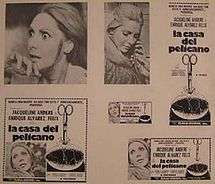Antonio González Caballero
| Antonio González Caballero | |
|---|---|
| Born |
1927 San Luis Potosí, San Luis Potosí[1] |
| Died |
2003 Mexico City, Mexico |
| Occupation | Screenwriter |
| Known for | Nilo, mi hijo |
| Parent(s) |
Don González Doña Caballero |
Antonio González Caballero (Spanish pronunciation: [anˈtonjo ɣonˈθaleθ kaβaˈʎeɾo]) (1927–2003) was a Mexican painter, pedagogue and screenwriter.[2][3] His most famous work is the play Nilo, mi hijo.[4] Famous film La Casa del Pelícano is based on it.[5][6]
He was born in San Luis Potosí, San Luis Potosí to Don González and Doña Caballero. He died in Historic center of Mexico City.
Works
- Señoritas a Disgusto[7] (1960)
- Una pura y dos con sal (1961)
- El medio pelo (1962)
- Nilo, mi hijo (1963)
- Los jóvenes asoleados (1965)
- Tres en Josafat (1965)
- Las vírgenes prudentes (1967)
- La ciudad de los carrizos (1967)
- Asesino imperfecto (1967)
- Una reverenda madre (1968)
- El estupendhombre (1971)
- Las devoradoras de un ardiente helado (1972)
- El mago (1973)
- Los amigos o La proliferación[8] (1975)
- Amorosos amorales (1980)
- El retablo (1982)
- Vicente y María (1984)
- ¿Quiere usted concursar? (1985)
- El Plop o Cómo escapar de la niebla[9] (1990)
- La maraña (1990)
- El pisapapel (1991)
- Cuestión de opiniones en regla de tres acerca del yo (1991)
- En ausencia de... (1992)
- Las embarazadas (1992)
- Amordidas (1993)
- Los nudistas del buzón sentimental (1993)
- El siniestro y escalofriante doctor Frederik Ludwing von Mamerto o Antes de ver a un psicólogo consulta con tu abogado o Y tú, ¿quién eres? (1993)
- Delito en el escenario (1994)
- La señora y sus amibas (1997)
- Vete al diablo, vida mía[10] (1999)

Nilo, mi hijo
Nilo, mi hijo is the most famous work by Caballero. It was filmed under the title La casa del pelícano ("The House of the Pelican").[11][12]
The main character Nilo was played by well known and beloved Enrique Álvarez Félix.[13] Nilo’s raped mother Margarita was Jacqueline Andere, and young Daniela Romo also appeared.[14][15]
The film was shocking for some commentators who noticed a connection between castration of Nilo and Enrique’s difficult relationship with his mother.[16]
On the poster for the film an egg is depicted. It is pierced by scissors. This is a symbolic representation of emasculation.
References
- ↑ Encyclopedia of Latin American Theater by Eladio Cortés, Mirta Barrea-Marlys. This volume traces the history of Latin American theater, including the Nuyorican and Chicano theaters of the United States, and surveys its history from the pre-Columbian period to the present.
- ↑ González Caballero, Antonio (2005). Obras de Vanguardia de Antonio González Caballero.
- ↑ Mijares, Enrique (2005). Prólogo a Obras de Vanguardia de Antonio González Caballero. Vol. I. México, D.F.: Pax.
- ↑ Nilo, mi hijo
- ↑ La Casa del Pelícano on IMDb
- ↑ La Casa del Pelícano (1977)
- ↑ Señoritas a disgusto
- ↑ Amigos o proliferación
- ↑ El plop o cómo escapar de la niebla
- ↑ Vete al Diablo vida mía
- ↑ La casa del Pelícano
- ↑ La Casa del Pelícano on IMDb
- ↑ Enrique Álvarez Félix on IMDb
- ↑ La Casa del Pelícano (1977)
- ↑ Daniela Romo's acting in La Casa del Pelícano
- ↑ Celluloid Nationalism and Other Melodramas by Susan Dever, page 185. "For spectators who followed national news reports about the late Enrique Álvarez Felixʻs allegedly difficult relationship with (his) real-life mother María Félix, it may be hard to ignore the irony of Alvarez Felixʻs character suffering castrating stabs."